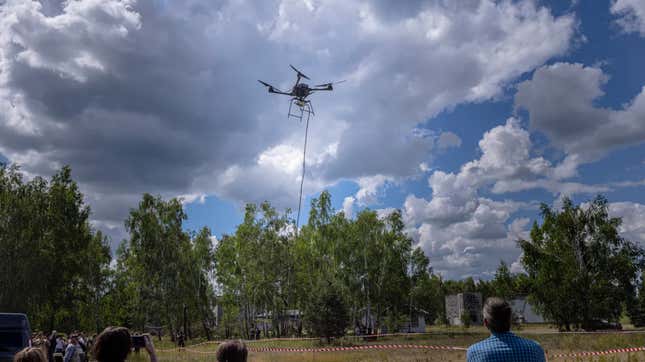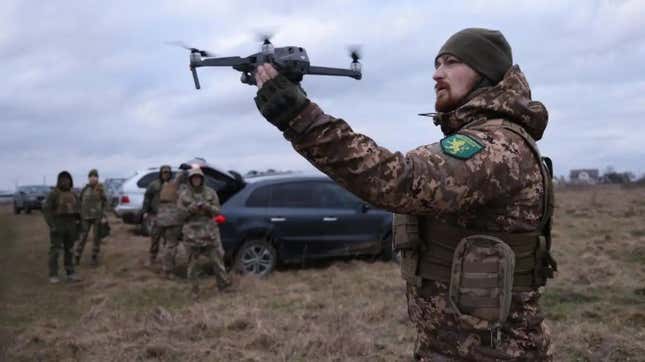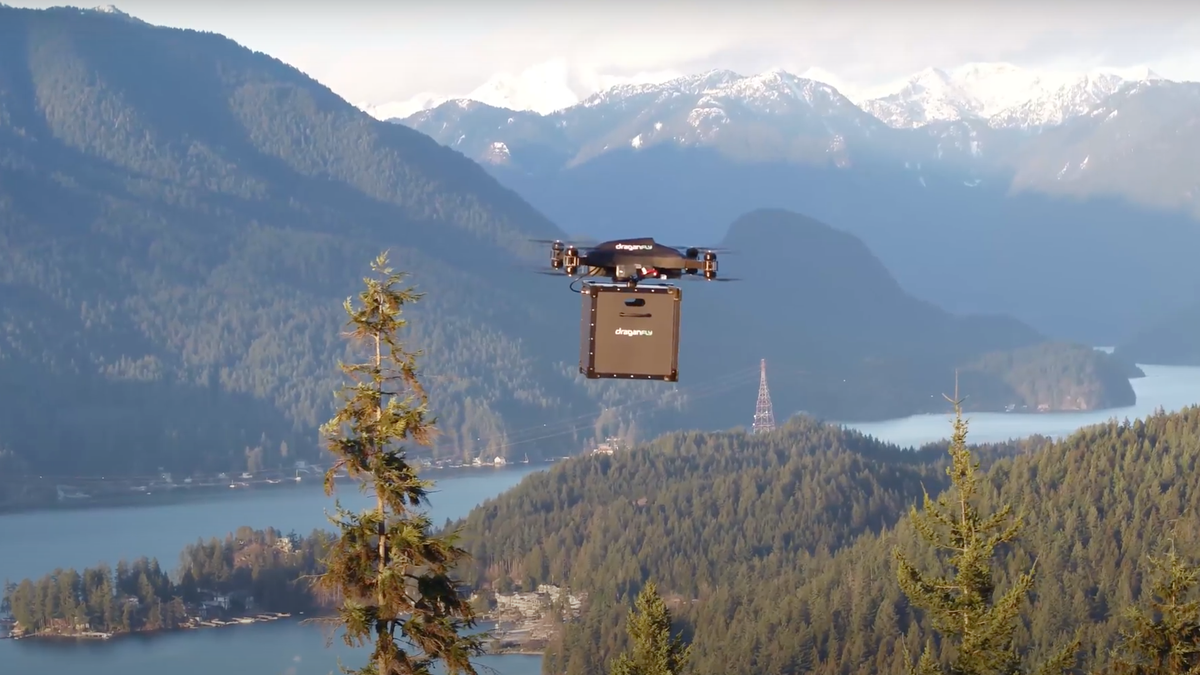When Draganfly launched as a small drone company in 1998, its co-founders did not predict hobbyist products like theirs would one day become, in the words of CEO Cameron Chell, “bigger than the advent of the tank in World War I.” Now, 25 years later, Draganfly’s drones—which are credited by the Smithsonian as being the first public service drone to save a human life—are buzzing above warzones in Ukraine helping zero in on deadly mines and scout ahead for signs of enemy forces.
Draganfly has been chosen to train Ukrainian drone operators, who are themselves relying increasingly on machines that could be mistaken for an Amazon order to push back the Russian offensive. The company once best known for helping save hikers now stands shoulder to shoulder with a country at war.
“We’ll be training up to a thousand new pilots per year and likely increasing that number as things move forward,” Chell said during a Zoom meeting with Gizmodo. “The best drone pilots in the world are in Ukraine right now.”
Chell, who became CEO in 2013, says Draganfly began sending drones to Ukraine near the beginning of the conflict after an NGO asked to use one of its medical response drones, capable of sending temperature-controlled aid and supplies. The company has since sent over 40 drones to the country to provide medical supplies, assist search and rescue missions, and provide reconnaissance. As the war raged on, however, it quickly became clear the camera-equipped quadcopters could serve another crucial purpose: spotting landmines.
Antipersonall landmines are prohibited under United Nations war guidelines, but that hasn’t stopped the Russian military from packing Ukraine full of them. Exact figures vary but Human Rights Watch estimates Russian forces have laid mines in at least 11 of Ukraine’s 27 regions. HALO Trust, an organization that clears landmines, says it has tracked more than 2,300 incidents involving mines since the conflict began, grimly crowning Ukraine the world’s most heavily mined country. Those lingering bombs threaten the lives of both soldiers and civilians.
“Ukraine is now by far the most mined country in the world,” Chell said. “It wasn’t the case two years ago.”
Demining teams in Ukraine use Draganfly drones to fly high above potentially contaminated zones and map out areas with mines before humans go in for manual removal. The stroller-sized aerial drones use a combination of thermal, hyperspectral, and magnetometer sensors to scout ahead and look for rustled foliage, unusual metal, or other anomalies that point to the existence of a deadly explosive. The overwhelming volume of unexploded ordinances cluttering the country means deminers need all the help they can get deciding what areas to prioritize and when. Deming is a painstakingly slow process, but Chell believes Draganfy’s drones are speeding that up and upping the efficiency of teams on the ground.
Recently, Draganfly drones were deployed in response to the recent collapse of the Nova Kakhovka dam. Chell says water from the dam flowed through an already mined region, sending potentially fatal explosive devices swimming through the region. The company’s drones helped make sense of chaos and performed search and rescue missions. Ukraine blames Russia for destroying the dam.

But there’s another, less pacifist element of drone adoption in Ukraine as well. Soldiers on the front lines have scraped together cheap hobbyist drones and modified them to spot artillery encampments and, in some cases, drop grenades on energy soldiers. These exploding drones, according to a recent New York Times article, are common enough to have gained their own distinction: “loitering munitions.” In some cases, these small drones are reportedly capable of dropping munitions powerful enough to destroy armored vehicles. In other cases, Ukraine has used explosive “Kamikaze Drones” to slam into soldiers and vehicles and self-destruct.
Chell wouldn’t speculate on whether Ukrainian forces have repurposed Draganfly’s drones to kill Russian troops but said there’s “a lot of information that we’re not privy to.” Still, the long-term impact of drones on the battlefield—both offensive and defensive—wasn’t lost on the CEO. Looking forward, Chell believes the proliferation of drones is a “game changer” and marks a bigger shift in military operations than the advent of the tank in the first world war.
“Other than the Ukrainian resolve and Ukrainians being supplied by NATO with enough weapons to defend themselves, there’s probably been no other bigger singular identifiable piece of equipment used that’s had as big of impact as small drones,” he said.
When asked how he reconciled evolving from a purely humanitarian drone company to one increasingly inching towards combat zones, Chell said the choice to work with military partners really isn’t a choice at all. Echoing the words of prominent artificial intelligence creators, the Draganfly CEO said someone else would inevitably create the products if they didn’t. Draganfly, Chell added, does not create ordinance. Instead, he compared his products to other tools like trucks or airplanes, which can both be used to get where you need to go or leave a building in smoldering ruin.
“We make the best drones available to do the best work possible,” Chell said. “Putting our head in the sand and pretending that somebody else isn’t doing the same thing and that just because they won’t is absolutely naive.”
The following interview has been edited for length and clarity.

How did Draganfly get started with demeaning missions in Ukraine?
An NGO based in the US that does work in Ukraine called Revived Soldiers called us and said they couldnt get their ambulances into besieged cities. Their ambulances were literally getting confiscated, shot, blocked. They asked if they could use our drones equipped with a medical temperature box to get supplies, insulin in particular. We donated three drones as an experiment and gave them the training that we could. Since that time, we’ve now deployed over 40 drones into the area to do things like medical delivery, search and rescue, and reconnaissance. In particular, there’s a very big demand for landmine detection, so we built out a system of drones and sensors that actually work with the demining companies to provide maps of anomalies in the fields before they go to work.
How prevalent of an issue are mines in Ukraine?
It’s going to take 40 years to demine Ukraine. For every day of war, there’s 30 days of demining and now that the US is sending over cluster munitions as well, that number’s going to go up significantly. There’s also about 40% of Russian munitions that don’t explode, so you’ve also got unexploded ordinance all over the place. Much of the work of the drone is to go out and map and then help decide, okay, which area are we going to try to go after first?
What type of sensors are used in the drones to map out these areas?
It’s a combination. The most important one actually is still just an RGB camera. It will allow you to see where foliage has been rustled, where tracks are, or the location of spent munitions or foxholes. For more details you’ll typically have a hyperspectral camera. It’s a camera that sees things in different wavelengths than what we can see in the eye so it’ll pick up different densities.
Then we’ll use magnetometers that will pick up metal. That’s not great in urban areas but in open fields it’s pretty telling. The other one that’s really important is thermal. We’ll fly thermal missions in the morning early when it’s not quite as hot and then we will fly a thermal mission in the afternoon. What that does is that it will heat the plastics up. If they’ve got improvised mines over there that made out of wood, or they’ve got plastic mines or things like that. That actually is really good for a lot of the smaller anti-personnel mines as well.
We’ve experimented with ground-penetrating radar as well, and had some success. It’ll be a little bit of time before we get it to the spot where it’s real-time, but it’s still a thousand times better than just sending people in blind into a field of poking sticks.
Are the landmines you are discovering primarily old ordnance from past conflicts or new explosives laid by the Russian military?
This is basically net new. There was certainly stuff from 2014 forward in the eastern part towards Crimea but Ukraine is now by far the most mined country in the world. It wasn’t the case two years ago.
How difficult is it to conduct operations in an active military zone?
Certainly our lead crews out there have been pulled back more times than not. Obviously, we take safety super seriously. We have two scenarios. One, where we do the training if we can and we turn over drones and then whatever happens or whatever they do with them, they do with them, that’s their gig. And then we do have a scenario where we have our own crews that are flying as well, and if there’s any ordinance or live event coming in, we have to pull out and move out of the situation quickly.
You’ve mentioned interest in using swarms, large groups of drones working together in tandem, for demining operations. Why would that be useful?
Throwing up a whole bunch of drones at a particular objective can be highly effective because it’s confusing and it is overwhelming to try to take them all down. The jamming techniques to take down swarms are very different from the jamming techniques to take down an individual drone. So if you’re trying to take down a swarm, you typically have to have very, very powerful jamming.
If you’re taking down a swarm, you’re jamming “all” the frequencies which means your generally affecting all your own equipment and communications as well. That’s why swarming has proven in some cases to be very effective in missions whether they’re surveillance missions or even combat missions.
Tell me about your drone training program in Ukraine
Draganfly is now doing all the drone training for pilots coming out of the Ministry of Interior. They’re standardizing their training because right now drones don’t have a central command and control structure. So we’ll be training up to a thousand new pilots per year and likely increasing that number as things move forward. Now, listen, the best drone pilots in the world are in Ukraine right now. They’re amazing. But in terms of process, protocol, standard operating procedure, advanced equipment, supply of Draganfly equipment, all of those types of things, that’s where we can really start to make an impact. And so this is a very, very big deal for us. And we think it’s the first really of its kind in the world.
There were many stories, particularly early in the conflict, of Ukrainian soldiers using off-the-shelf commercial drones like the kinds you would find on Amazon to conduct operations. What do you think about that sudden reliance on small drones for warfare?
Other than the Ukrainian resolve and Ukrainians being supplied by NATO with enough weapons to defend themselves, there’s probably been no other bigger singular identifiable piece of equipment used that’s had as big of an impact as small drones. Air dominance in the past has been manned aircraft, satellites, etc, so you had to be a very big player in order to have continuous air dominance. Today, air dominance, no matter how big you are, it’s all small UAS [Unmanned Aerial Systems]. You’re seeing massive budgets now moving towards small UAS because it beats manned systems and it’s incredibly cost-effective compared to putting people up in the air to train and all the rest of it that goes with it.
It’s a lot easier to get ahold of drone parts and piece ‘em together and use them for observation or artillery targeting or even dropping of grenade ordinance. It’s a lot easier to put drones together than it is to get counter-drone technology to the front line, and it’s just much more sophisticated. So it’s been highly effective but more and more we’re seeing that the drones have got to step up a notch.
What larger impact do you think the shift to small drones will have on warfighting moving forward?
Everybody’s buying drones now and there are requests for very specific types of drones that do very specific types of things. This is bigger than the advent of the tank in World War I, by an order of magnitude. By Far. You’ve got airborne lethality at a patrol level, a two-person patrol now has airborne capabilities, communication and ordinance. It’s game-changing.
How do you grapple with the tension of starting as a humanitarian company and watching drones evolve to a point where they now have viable offensive capabilities? How do you think about that evolving tension?
I think there are two things to think about. I think about a truck, the automobile and the impact they have had on the world. All of these things are going to get militarized for right, wrong or indifferent reasons. We’re not going to stop that. Our drones have done an incredible amount of good in the world, and we’re going to continue to build great drones so that they can do public safety so that they can do wireline inspections, forestry, and wildfire work, all of which we do. Our view on the military thing is the choice is really not much of a choice either.
We make the best drones available to do the best work possible. Putting our head in the sand and pretending that somebody else isn’t doing the same thing is absolutely naive. We have to put the best equipment forward 100%. Where we draw the line is we don’t build ordinance but we certainly build the best equipment possible for our people who are defending our freedom. And we’re going to continue to do that, and we’re very passionate about it.
#Draganfly #Drones #Helping #Remove #Landmines #Ukraine












